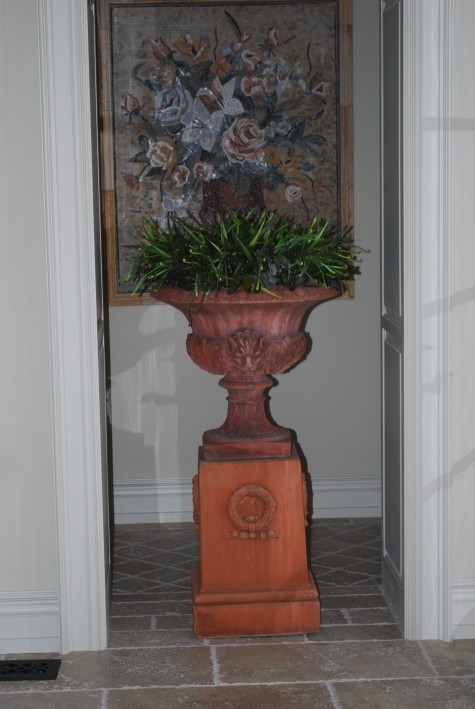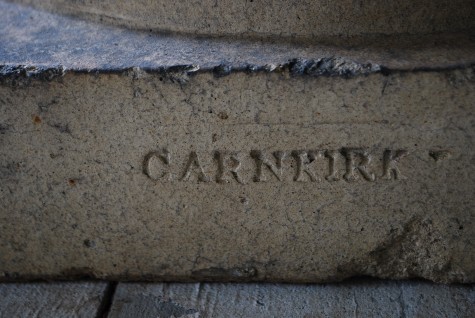 It has been three years since I have shopped for garden ornament in England. This past October, Rob travelled to England and shopped furiously over the course of 2 weeks; just 2 days ago, our first container was finally delivered. The shipping has always been an arduous experience, but this shipment was a lesson in the new world order. No dirt, unknown organisms or moss could be imported. My customs broker requested a crew to come to their warehouse-to dry brush any and all soil and moss from our antique and vintage garden items. I was reluctant to remove all of the beautiful evidence of age, but I complied. The rare Scottish Garnkirk fireclay urn circa 1860-1870 pictured above-I just wanted to have it in my possession, along with all of the other things aboard our container.
It has been three years since I have shopped for garden ornament in England. This past October, Rob travelled to England and shopped furiously over the course of 2 weeks; just 2 days ago, our first container was finally delivered. The shipping has always been an arduous experience, but this shipment was a lesson in the new world order. No dirt, unknown organisms or moss could be imported. My customs broker requested a crew to come to their warehouse-to dry brush any and all soil and moss from our antique and vintage garden items. I was reluctant to remove all of the beautiful evidence of age, but I complied. The rare Scottish Garnkirk fireclay urn circa 1860-1870 pictured above-I just wanted to have it in my possession, along with all of the other things aboard our container.
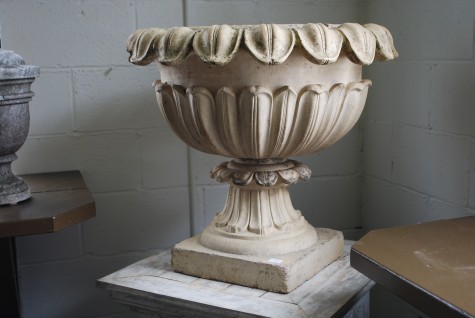
Antique garden ornaments have that history that guarantees a story. What are those stories? The Garnkirk company was founded opened for business in 1832, by Mark Sprot. He had purchased Garnkirk House in 1811; the Garnkirk Colliery and Brickfield was created nearby. The name was later changed to the Garnkirk Fireclay Company. Their fireclay, used to manufacture firebricks and firebrick products, quickly gained a reputation for very high quality and an exceptional light color. A business in brick, glazed water pipes and other architectural items expanded into beautiful objects for the garden. By 1833, it became apparent that the ornamental products they made for gardens were a growing and important part of the company. Garnkirk garden ornament was said to “exhibit pleasing forms and a soft mellow shade of color, harmonizing admirably the hue of foliage and turf”. This reference comes from the Horticulturist, in an article published in July of 1848. My source for this? A Sotheby’s auction catalogue from 1999.
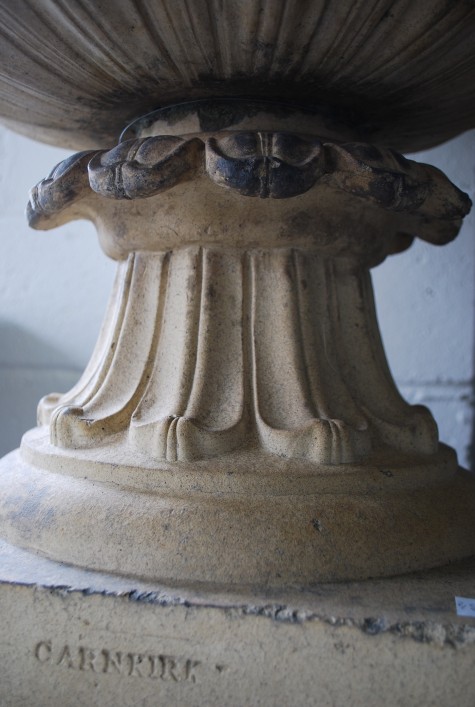 The Garnkirk Fireclay Company was the largest of its kind in Britain. The seam bed of fireclay varied in thickness from four to nineteen feet, located some 150 feet below the surface. The clay was of a composition such that objects made from it had great strength and beauty. The same could be said for the clay found in Impruneta, Italy; entire local industries developed from the availability of beautiful and strong clay. Garnkirk products were shipped all over the world, including the US.
The Garnkirk Fireclay Company was the largest of its kind in Britain. The seam bed of fireclay varied in thickness from four to nineteen feet, located some 150 feet below the surface. The clay was of a composition such that objects made from it had great strength and beauty. The same could be said for the clay found in Impruneta, Italy; entire local industries developed from the availability of beautiful and strong clay. Garnkirk products were shipped all over the world, including the US.
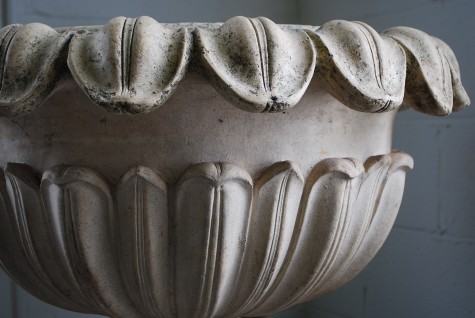 In 1869, their employees numbered close to three hundred. Some 200 tons of clay were used daily. By 1895, the fireclay pits were exhausted. The company continued production until 1901, when it closed. It is easy to see why this particular clay was so prized. It has a dense and smooth surface which reflects light beautifully. I am sure that density has much to do with the fact that these urns have relatively little damage, considering that they are 151 years old.
In 1869, their employees numbered close to three hundred. Some 200 tons of clay were used daily. By 1895, the fireclay pits were exhausted. The company continued production until 1901, when it closed. It is easy to see why this particular clay was so prized. It has a dense and smooth surface which reflects light beautifully. I am sure that density has much to do with the fact that these urns have relatively little damage, considering that they are 151 years old.
 The urns have been colonized by moss, and have patches of black typical on garden ornament from this period. The engine powering the industrial revolution in the British Isles was coal. I have seen limestone pieces completely blackened from coal smog.
The urns have been colonized by moss, and have patches of black typical on garden ornament from this period. The engine powering the industrial revolution in the British Isles was coal. I have seen limestone pieces completely blackened from coal smog.
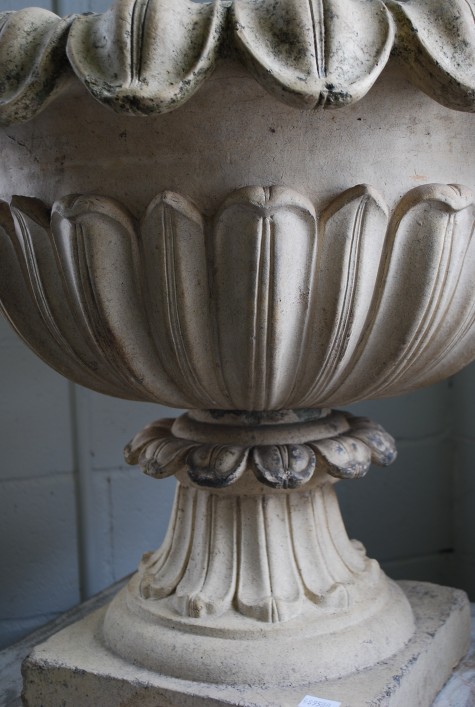 None of the research I have done on these urns has revealed who designed them. The petalled rim is quite beautiful and sculptural, and clearly derived from natural forms. The incised detail is crisp and dramatic. The proportions are handsome. Some very talented person designed these-would that I could know something about them.
None of the research I have done on these urns has revealed who designed them. The petalled rim is quite beautiful and sculptural, and clearly derived from natural forms. The incised detail is crisp and dramatic. The proportions are handsome. Some very talented person designed these-would that I could know something about them.
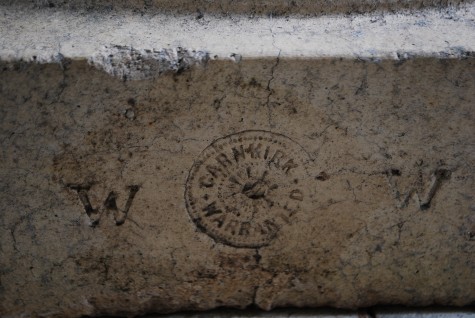
I only know where these urns were for the past year; this leaves 150 years unaccounted for. I do so wish that story could be told; I am sure it would be a tale worth listening to.
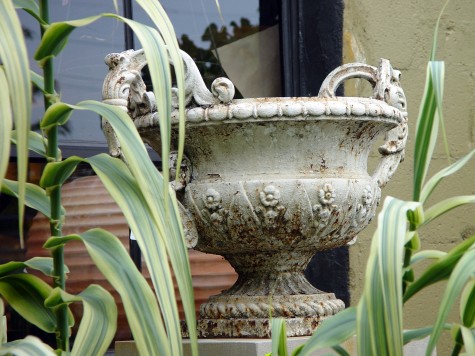 Gardeners make choices based on lots of issues, but most can figure out what appeals to them straight off. Some love old crusty, rusty and well worn antiques; others find that state of gentle disrepair lacks visual punch. Many antique urns have been painted at one time or another; white having been a very popular color. Worn white will either be just the thing, or seem jarring. For others, the prospect of a classical urn leaves them cold-old or new. But if the idea of an urn resonates with you, which you will choose depends on several things.
Gardeners make choices based on lots of issues, but most can figure out what appeals to them straight off. Some love old crusty, rusty and well worn antiques; others find that state of gentle disrepair lacks visual punch. Many antique urns have been painted at one time or another; white having been a very popular color. Worn white will either be just the thing, or seem jarring. For others, the prospect of a classical urn leaves them cold-old or new. But if the idea of an urn resonates with you, which you will choose depends on several things. 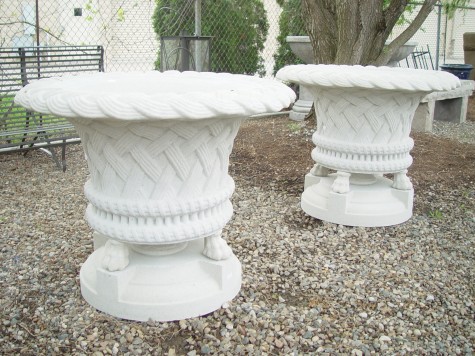 Dry cast limestone urns are usually based on classical handcarved limestone designs dating back hundreds of years. Many of those designs are European in origin. Dry cast limestone is a process by which limestone dust is mixed with a binder, and poured into molds. These reproductions are much more affordable than their antique counterparts. Some old designs would not be available at all, but for a reproduction. On occasion I find a piece I feel I must have, with no placement in mind. But a classical European urn may be very much out of place in front of a Cape Cod home. Now would these elaborately footed urns ring right against the backdrop of my own arts and crafts style home. However, they might be elegant and unexpectedly beautiful in a contemporary setting. The location you have in mind should influence your decision.
Dry cast limestone urns are usually based on classical handcarved limestone designs dating back hundreds of years. Many of those designs are European in origin. Dry cast limestone is a process by which limestone dust is mixed with a binder, and poured into molds. These reproductions are much more affordable than their antique counterparts. Some old designs would not be available at all, but for a reproduction. On occasion I find a piece I feel I must have, with no placement in mind. But a classical European urn may be very much out of place in front of a Cape Cod home. Now would these elaborately footed urns ring right against the backdrop of my own arts and crafts style home. However, they might be elegant and unexpectedly beautiful in a contemporary setting. The location you have in mind should influence your decision.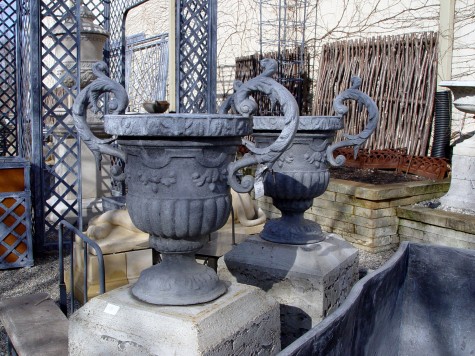 The scale of an urn is an important consideration. Very small urns may need pedestals to set them off properly. If the shape and decoration of an urn is a good bit of what you find appealing, then they need be placed where those things can be easily seen. Small urns have another significant disadvantage. From a small size follows a small planting area; you will need to edit your plant choices. Perhaps of more importance-how easily will you be able to water, and water again, when the weather gets hot? Small pots dry out faster than is easy to keep up with.
The scale of an urn is an important consideration. Very small urns may need pedestals to set them off properly. If the shape and decoration of an urn is a good bit of what you find appealing, then they need be placed where those things can be easily seen. Small urns have another significant disadvantage. From a small size follows a small planting area; you will need to edit your plant choices. Perhaps of more importance-how easily will you be able to water, and water again, when the weather gets hot? Small pots dry out faster than is easy to keep up with.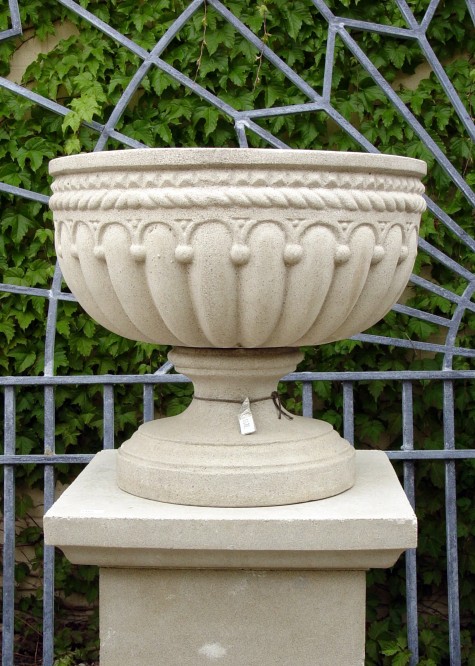 I like urns of a generous size. I have plenty of room to plant-either lots of one thing, or a collection. An urn planted such that in late summer it is a garden bouquet of good size is a pleasure. Watered properly, they retain moisture evenly, over a longer period of time. A container that can wait for me to get there with the hose- this I appreciate. Any urn I plant becomes part of the working garden. A gorgeous urn with a poor planting is a frustration no gardener needs.
I like urns of a generous size. I have plenty of room to plant-either lots of one thing, or a collection. An urn planted such that in late summer it is a garden bouquet of good size is a pleasure. Watered properly, they retain moisture evenly, over a longer period of time. A container that can wait for me to get there with the hose- this I appreciate. Any urn I plant becomes part of the working garden. A gorgeous urn with a poor planting is a frustration no gardener needs. 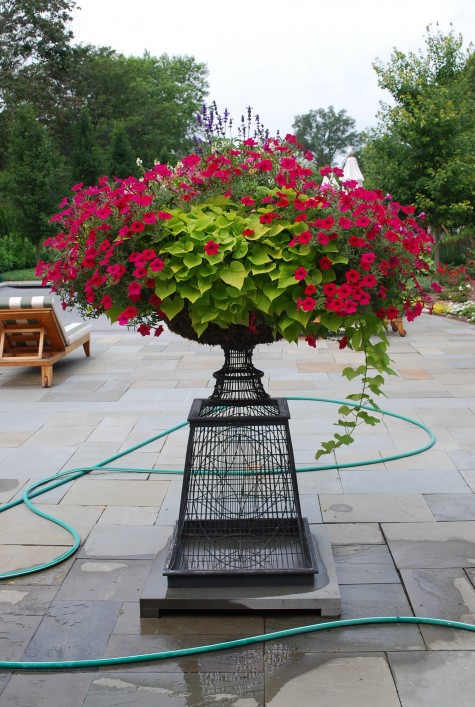
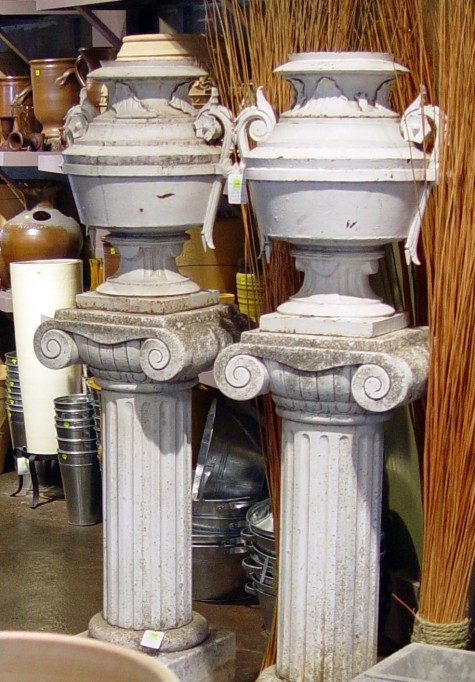 These French art deco style urns have such style and presence one might be inclined not to plant them. The Waterloo Urn I discussed in yesterday’s post is placed out in the open landscape. Unplanted, it could be placed anywhere calling for a sculpture-no need to have water conveniently nearby.
These French art deco style urns have such style and presence one might be inclined not to plant them. The Waterloo Urn I discussed in yesterday’s post is placed out in the open landscape. Unplanted, it could be placed anywhere calling for a sculpture-no need to have water conveniently nearby. 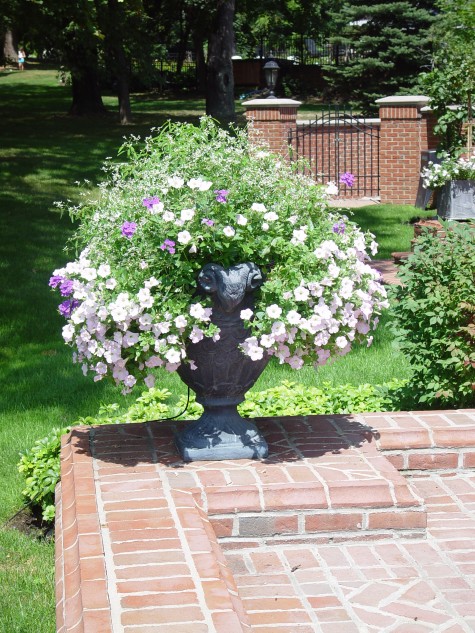 This lead urn is watered via a tube connected to the irrigation system in this yard. In much the same way as greenhouses tube their hanging baskets, or geraniums, these tubes buy a gardener a little time. They are not really a substitue for hand watering, as the coverage can be uneven, too long, or too short. If the tube runs on a nearby irrigation zone, that pot is at the water mercy of whatever else is being primarily watered. I am more than willing to look after my plantings; some automatic irrigation helps me to hedge this pledge. Those days that I come home really late will not need be a crisis. The level of your ability to maintain pot plantings is an important part of the selection process.
This lead urn is watered via a tube connected to the irrigation system in this yard. In much the same way as greenhouses tube their hanging baskets, or geraniums, these tubes buy a gardener a little time. They are not really a substitue for hand watering, as the coverage can be uneven, too long, or too short. If the tube runs on a nearby irrigation zone, that pot is at the water mercy of whatever else is being primarily watered. I am more than willing to look after my plantings; some automatic irrigation helps me to hedge this pledge. Those days that I come home really late will not need be a crisis. The level of your ability to maintain pot plantings is an important part of the selection process. 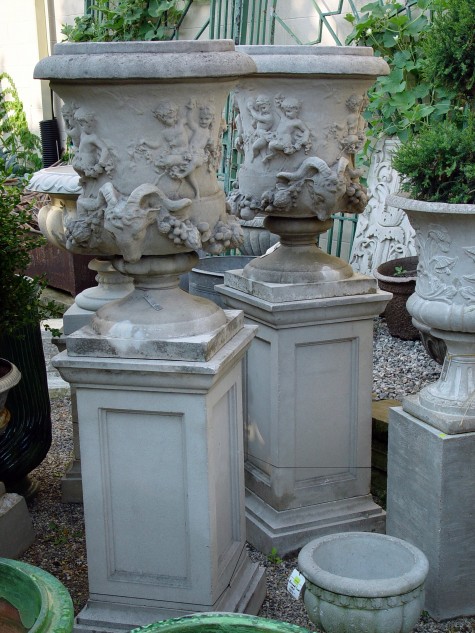 These concrete pots are English made reproductions, but they have that aged look. The surface is such that I would plant the tall, and vase shaped-nothing trailing. Ala some voluminously opulent Flemish flower painting. There is no choosing these pots if the decorative story being told does not greatly appeal-why cover up what so appealed to you in the first place? In this case, the urns and there plantings need to strike a balance, so they look great in relationship to one another.
These concrete pots are English made reproductions, but they have that aged look. The surface is such that I would plant the tall, and vase shaped-nothing trailing. Ala some voluminously opulent Flemish flower painting. There is no choosing these pots if the decorative story being told does not greatly appeal-why cover up what so appealed to you in the first place? In this case, the urns and there plantings need to strike a balance, so they look great in relationship to one another. 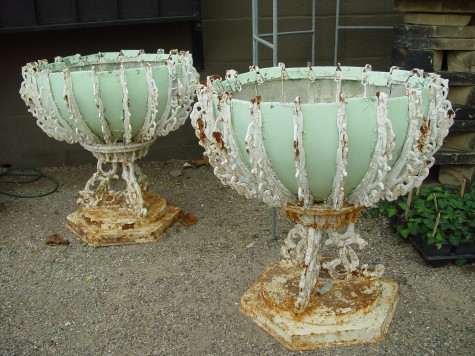
![1660164496_ce85d76e9b_o[1] 1660164496_ce85d76e9b_o[1]](https://deborahsilver.com/wp-content/uploads/2010/02/1660164496_ce85d76e9b_o1.jpg)
![15a1[1] 15a1[1]](https://deborahsilver.com/wp-content/uploads/2010/02/15a11.jpg) When I first got interested in dealing in garden antiques, it was tough going- educating myself about them. Outside of a few well known reference books, garden auction catalogues proved helpful. A garden urn, I learned, is a container with a foot, or pedestal. The small urn pictured above was manufactured by the Coalbrookdale Ironworks in England in the 19th century, and is a handsomely proportioned piece.
When I first got interested in dealing in garden antiques, it was tough going- educating myself about them. Outside of a few well known reference books, garden auction catalogues proved helpful. A garden urn, I learned, is a container with a foot, or pedestal. The small urn pictured above was manufactured by the Coalbrookdale Ironworks in England in the 19th century, and is a handsomely proportioned piece. ![C0671[1] C0671[1]](https://deborahsilver.com/wp-content/uploads/2010/02/C06711.jpg)
![256[1] 256[1]](https://deborahsilver.com/wp-content/uploads/2010/02/2561.jpg)
![831[1] 831[1]](https://deborahsilver.com/wp-content/uploads/2010/02/8311.jpg) These American concrete urns on associated pedestals came from the Philadelphia area. They are among the most favorite garden urns that have ever come my way. The bell shape is decorated with what seems like thistles to me. I know little else about them. They are in very fragile condition; I bring them in for the winter. Their rims have been so worn by rain and exposure to the elements that I can see the aggregate in the concrete mix clearly. Stately and frail, they are.
These American concrete urns on associated pedestals came from the Philadelphia area. They are among the most favorite garden urns that have ever come my way. The bell shape is decorated with what seems like thistles to me. I know little else about them. They are in very fragile condition; I bring them in for the winter. Their rims have been so worn by rain and exposure to the elements that I can see the aggregate in the concrete mix clearly. Stately and frail, they are.![C1311[1] C1311[1]](https://deborahsilver.com/wp-content/uploads/2010/02/C13111.jpg) These diminuitive concrete urns have a highly textured surface, just like my thistle urns. They are old-vintage-pieces, not antiques. The faded red color is unusual, and the shape is beautiful. I could easily see them indoors. Old garden urns are fine unplanted. They have an aura and a presence that needs nothing else, should the sculpture alone please you.
These diminuitive concrete urns have a highly textured surface, just like my thistle urns. They are old-vintage-pieces, not antiques. The faded red color is unusual, and the shape is beautiful. I could easily see them indoors. Old garden urns are fine unplanted. They have an aura and a presence that needs nothing else, should the sculpture alone please you.
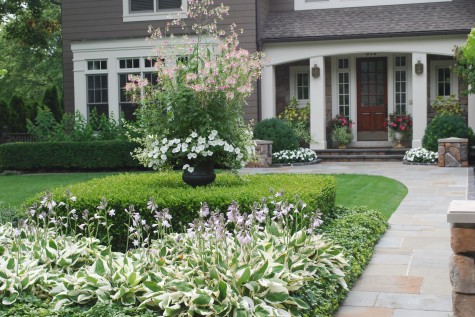
 My own Italian terra cotta garden urns on plinths from Mital-I so love them. I trim what ever obscures their decoration. In the winter, I move them to my front porch, and plant them for the holidays. The rest of the winter they are empty, awaiting spring.
My own Italian terra cotta garden urns on plinths from Mital-I so love them. I trim what ever obscures their decoration. In the winter, I move them to my front porch, and plant them for the holidays. The rest of the winter they are empty, awaiting spring. 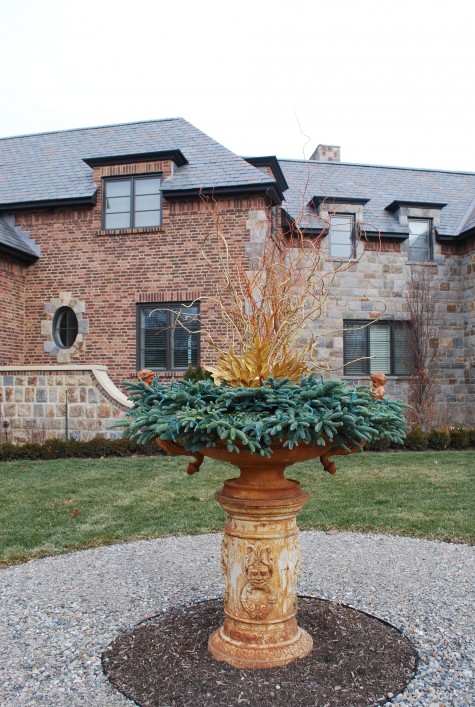 Antique urns take to a winter planting with ease. This client landscaped her yard to celebrate her fine antique footed pots. I completely understand this gesture.
Antique urns take to a winter planting with ease. This client landscaped her yard to celebrate her fine antique footed pots. I completely understand this gesture. 